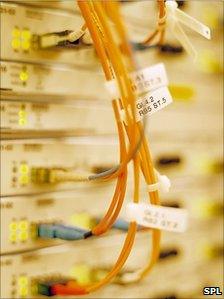Fibre optic cables' data capacity may soon be reached
- Published

Technology may stretch the capacity of the fibre optic cables used to carry data sooner than has long been thought, according to a report in Science.
The capacity limit has until recently been in the preparation of the light signals that pass through the cables.
But the report reviews recent laboratory results showing data rates that are more than half the ultimate limit of fibre optic cables.
It calls for urgent research to develop higher-bandwidth cables.
A number of innovations have in the past massively increased the data capacity of optical fibres.
The first change improved the transmission of the fibres, so that optical signals did not simply get absorbed as they passed through.
This resulted in fibres with data rates hundreds of times higher and theoretical capacities thousands of times higher than that.
Those improved fibres have become standard and now lie underground and undersea all over the globe; the limitation since then has been in the lasers and electronics that prepare and then translate the optical signals on either side of these "light pipes".
Now, David Richardson of the University of Southampton's Optoelectronics Research Centre says in the Science report that the best data rates measured in laboratory settings challenge the perceived notion that fibres are limitless conduits for data.
"The thought that the current fibre technology has infinite capacity is not true - we are beginning to hit the fundamental limits of the current technology," he told BBC News.
"We need to be looking at the next big breakthrough to allow us to continue to scale as we have traditionally done."
He said there are more increases to be had, for instance, in the way the light signals are encoded, but that "radical" gains will likely come from changes in the fibres themselves.
"If you gain a factor of two in bandwidth by developing a whole new amplifier technology, that's perhaps two or three years of capacity growth. To get radical changes - to get factors of 100 or 1000 - it's going to be extremely demanding.
"It's likely we're going to have to go right back to the fundamentals of the optics, the actual light pipes. And if you want to develop the next generation of cable, you want to be doing that 10 years in advance, not for tomorrow."
Market forces
Of course, the point at which the data rates required by internet users outstrip capacity depends only on how fast demand rises - a notoriously difficult figure to predict, as Geoff Bennett of telecoms firm Infinera points out.
"A small change in growth rate makes a big difference to the final numbers," he told BBC News.
"But whichever way it goes, it will be driven by market forces. Today, video is the only application we know that is stressing internet capacity. If people want YouTube or iPlayer video in 3D, '4k' high-definition, then maybe they'll have to pay more for it. And that will limit demand; that's how every other market works."
For his part, Dr Richardson feels that behavioural changes, as much as market forces, could easily push the limitations out later.
"Changes in the way we use the internet may well deal with it very straightforwardly," he said.
Or, as he wrote in the Science paper: "We may all increasingly need to get used to the idea that bandwidth - just like water and energy - is a valuable commodity to be used wisely."
- Published1 March 2012